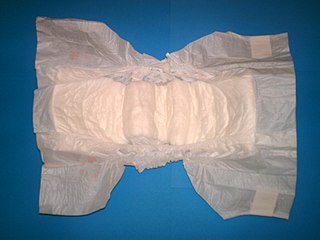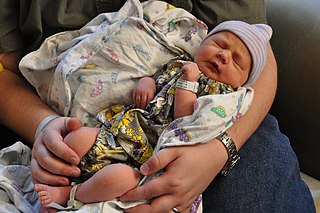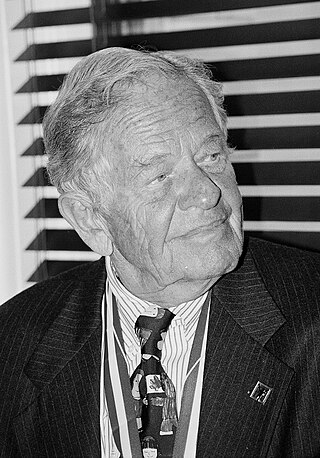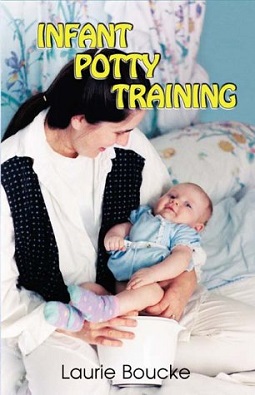
Toilet humour, or potty or scatological humour, is a type of off-colour humour dealing with defecation, diarrhea, constipation, urination and flatulence, and to a lesser extent vomiting and other bodily functions.

A diaper or a nappy is a type of underwear that allows the wearer to urinate or defecate without using a toilet, by absorbing or containing waste products to prevent soiling of outer clothing or the external environment. When diapers become wet or soiled, they require changing, generally by a second person such as a parent or caregiver. Failure to change a diaper on a sufficiently regular basis can result in skin problems around the area covered by the diaper.

An infant or baby is the very young offspring of human beings. Infant is a formal or specialised synonym for the common term baby. The terms may also be used to refer to juveniles of other organisms. A newborn is, in colloquial use, an infant who is only hours, days, or up to one month old. In medical contexts, a newborn or neonate is an infant in the first 28 days after birth; the term applies to premature, full term, and postmature infants.

Defecation follows digestion, and is a necessary process by which organisms eliminate a solid, semisolid, or liquid waste material known as feces from the digestive tract via the anus or cloaca. The act has a variety of names ranging from the common, like pooping or crapping, to the technical, e.g. bowel movement, to the obscene (shitting), to the euphemistic, to the juvenile. The topic, usually avoided in polite company, can become the basis for some potty humor.

Baby sign language is the use of manual signing allowing infants and toddlers to communicate emotions, desires, and objects prior to spoken language development. With guidance and encouragement, signing develops from a natural stage in infant development known as gesture. These gestures are taught in conjunction with speech to hearing children, and are not the same as a sign language. Some common benefits that have been found through the use of baby sign programs include an increased parent-child bond and communication, decreased frustration, and improved self-esteem for both the parent and child. Researchers have found that baby sign neither benefits nor harms the language development of infants. Promotional products and ease of information access have increased the attention that baby sign receives, making it pertinent that caregivers become educated before making the decision to use baby sign.

Thomas Berry Brazelton was an American pediatrician, author, and the developer of the Neonatal Behavioral Assessment Scale (NBAS). Brazelton hosted the cable television program What Every Baby Knows, and wrote a syndicated newspaper column. He wrote more than two hundred scholarly papers and twenty-four books.
The Neonatal Behavioral Assessment Scale (NBAS), also known as the Brazelton Neonatal Assessment Scale (BNAS), was developed in 1973 by T. Berry Brazelton and his colleagues. This test purports to provide an index of a newborn's abilities, and is usually given to an infant somewhere between the age of 3 days to 4 weeks old. The test is designedf to describe the neonate's response to the environment after being born. This approach was innovative for recognizing that a baby is a highly developed organism, even when just newly born. The profile describes the baby's strengths, adaptive responses and possible vulnerabilities. This knowledge may help parents develop appropriate strategies for caring in intimate relationships to enhance their earliest relationship with the child.

Toilet training is the process of training someone, particularly a toddler or infant, to use the toilet for urination and defecation. Attitudes toward training in recent history have fluctuated substantially, and may vary across cultures and according to demographics. Many of the contemporary approaches to toilet training favor a behaviouralism- and cognitive psychology-based approach.
Baby talk is a type of speech associated with an older person speaking to a child or infant. It is also called caretaker speech, infant-directed speech (IDS), child-directed speech (CDS), child-directed language (CDL), caregiver register, parentese, or motherese.

Potty parity is equal or equitable provision of public toilet facilities for females and males within a public space.

A potty chair, or simply a potty, is a proportionately small chair or enclosure with an opening for seating very young children to urinate and defecate. It is a variant of the close stool which was used by adults before the widespread adoption of water flushed toilets. There are a variety of designs, some placed directly over the toilet called "Toilet Training Seats" so the egested fecal material drops directly into the toilet bowl thereby eliminating manual removal and disposal of the said waste from a receptacle beneath the hole which is often a bag or receptacle similar to a chamber pot. Potty chairs are used during potty training, a.k.a. toilet training. These are very useful for young babies.

Infant Potty Training: A Gentle and Primeval Method Adapted to Modern Living is a book about toilet training by Laurie Boucke. It is an expansion of ideas that were originally presented in a small self-published volume called Trickle Treat in 1991. Infant Potty Training was first published in 2000, is now in its third edition (2008), and has editions in German, Dutch, Italian and Japanese. Infant potty training is traditionally used in at least 80 countries.
Sleep training is a set of parental intervention techniques with the end goal of increasing nightly sleep in infants and young children, addressing “sleep concerns”, and decreasing nightime signalling. Although the diagnostic criteria for sleep issues in infants is rare and limited, sleep training is usually approached by parent(s) or caregivers self identifying supposed sleep issues.

Open-crotch pants, also known as open-crotch trousers or split pants, are worn by toddlers throughout mainland China. Often made of thick fabric, they are designed with either an unsewn seam over the buttocks and crotch or a hole over the central buttocks. Both allow children to urinate and defecate without the pants being lowered. The child simply squats, or is held by the parent, eliminating the need for diapers. The sight of the partially exposed buttocks of kaidangku-clad children in public places frequently astonishes foreign visitors, who often photograph them. They have been described as being "as much a sign of China as Chairman Mao's portrait looming over Tiananmen Square."
A wetness indicator is a common feature in many disposable diapers and toilet training pants. It is a feature that reacts to exposure of liquid as a way to discourage the wearer to urinate in the training pants, or as an indicator to a caregiver that a diaper needs changing.
Baby-led potty training is a system for meeting babies' toileting needs. The main feature of the system is that care-givers 'hold babies out' or support them on a potty in order for them to void in an appropriate place outside their nappy. The method is typically started before the baby is six months old. Care-givers use a combination of timing, and observing babies' own signals, to decide when to hold them out. In many countries it is the norm for parents to care for their babies without nappies from the first days of life. The term Baby-led potty training describes the method being used by a growing number of families in the UK. It is an adaptation of the techniques used in Africa, India and China amongst others, to fit into a modern Western life-style. It is similar to the US movement Elimination Communication, though UK proponents of the method emphasise its pragmatic approach with no strict rules, and it can be used by any type of parent. Some parents use the technique just occasionally, others as an alternative to full-time nappies, and some as a route to toilet independence.

Open defecation is the human practice of defecating outside rather than into a toilet. People may choose fields, bushes, forests, ditches, streets, canals, or other open spaces for defecation. They do so either because they do not have a toilet readily accessible or due to traditional cultural practices. The practice is common where sanitation infrastructure and services are not available. Even if toilets are available, behavior change efforts may still be needed to promote the use of toilets. 'Open defecation free' (ODF) is a term used to describe communities that have shifted to using toilets instead of open defecation. This can happen, for example, after community-led total sanitation programs have been implemented.
Diaper need is the struggle to provide a sufficient number of clean diapers to ensure that each diaper user can be changed out of wet or soiled diapers as often as necessary. An adequate supply of diapers is a basic need for all infants, as necessary for health and well-being as food and shelter. Adults and older children experiencing incontinence may also suffer from diaper need if they or their caretakers cannot acquire an adequate supply.

Foodborne illness is any illness resulting from the food spoilage of contaminated food, pathogenic bacteria, viruses, or parasites that contaminate food. Infant food safety is the identification of risky food handling practices and the prevention of illness in infants. Foodborne illness is a serious health issue, especially for babies and children. Infants and young children are particularly vulnerable to foodborne illness because their immune systems are not developed enough to fight off foodborne bacterial infections. In fact, 800,000 illnesses affect children under the age of 10 in the U.S. each year. Therefore, extra care should be taken when handling and preparing their food.

Infant crying is the crying of infants as a response to an internal or external stimulus. Infants cry as a form of basic instinctive communication. Essentially, newborns are transitioning from life in the womb to the external environment. Up to 27% of parents describe problems with infant crying in the first four months. Up to 38% identify a problem with their infant crying within the first year. Parents can be concerned about the amount of time that their infant cries, how the infant can be consoled, and disrupted sleeping patterns. Colic is used as a synonym for excessive crying of infants, even though colic may not be the cause of excessive crying.













